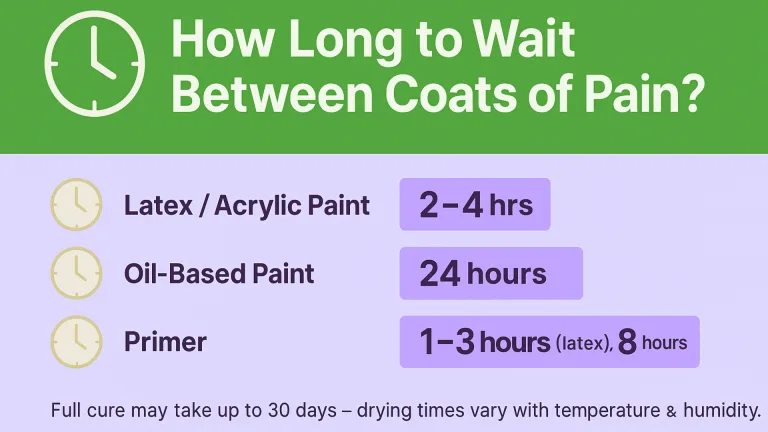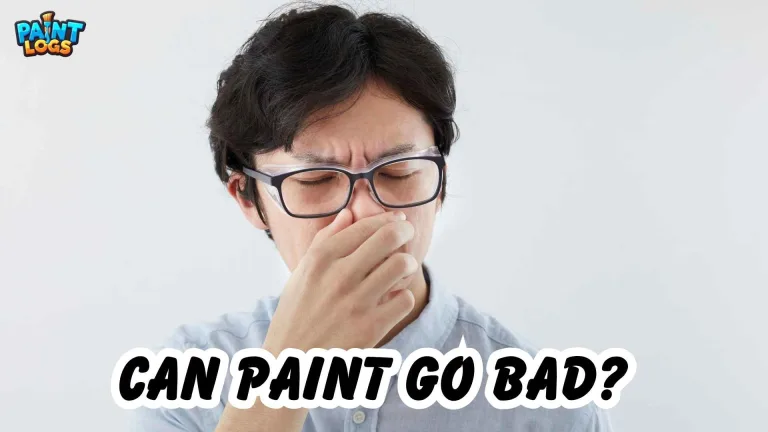Quick Answer: Is Mineral Spirits the Same as Paint Thinner?
No. Mineral spirits are a refined petroleum solvent used for thinning oil-based paints and cleaning brushes, while paint thinner is a broader category that may include mineral spirits plus harsher, cheaper solvents. Mineral spirits are less toxic, lower in odor, and better for most painting and woodworking tasks.
If you’ve ever worked with oil-based paints, varnishes, or wood finishes, you’ve probably run into two names that sound almost identical: mineral spirits Vs paint thinner. They sit side by side on hardware store shelves, cost about the same, and are often marketed for the same jobs—so it’s no wonder many DIYers and even pros get confused.
The truth is, knowing the difference matters. Whether you’re cleaning brushes, prepping wood, or thinning oil paint, the solvent you choose can affect your results, your safety, and even the longevity of your tools. And once you factor in other common solvents—like acetone, denatured alcohol, turpentine, and lacquer thinner—the choices get even more overwhelming.
This guide breaks it all down step by step, so you’ll know exactly which product to grab for any project—and never be left second-guessing at the hardware store again.
What Are Mineral Spirits?
Mineral spirits, sometimes labeled as white spirits or Stoddard solvent, are a refined petroleum product. They’re clear, colorless, and designed primarily for:
- Thinning oil-based paints and varnishes
- Cleaning brushes and rollers after use with oil-based coatings
- Degreasing metal parts or tools
- Preparing wood surfaces before staining or finishing
Unlike harsher solvents, mineral spirits are relatively mild. They evaporate at a slower rate than acetone or lacquer thinner, which makes them less aggressive and easier to control. Odorless or “low-odor” mineral spirits go one step further by removing much of the smelly volatile compounds.
👉 Quick fact: Artists also use refined mineral spirits (often sold as “OMS”) to thin oil paints without the heavy fumes of turpentine.
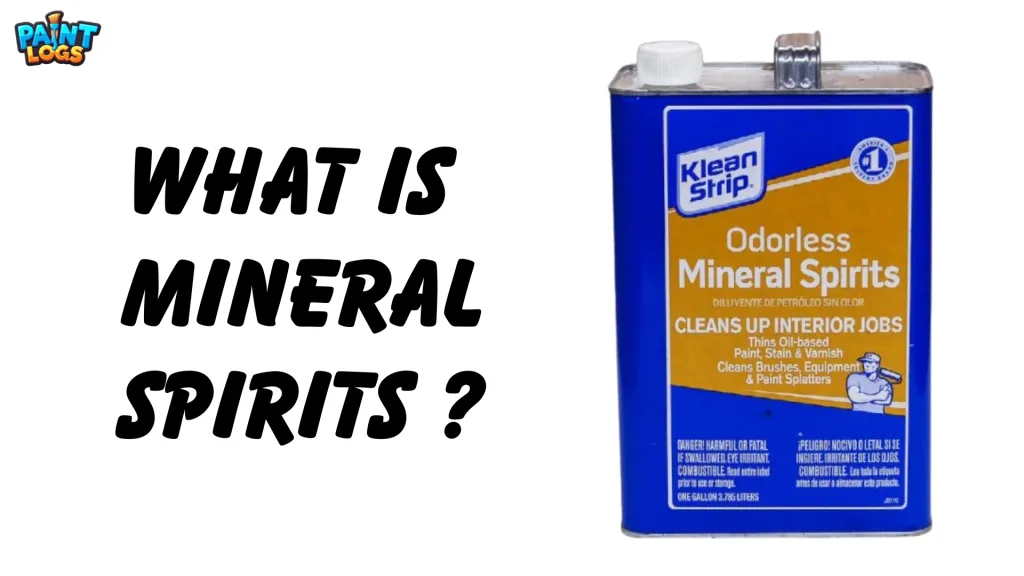
What Is Paint Thinner?
The term paint thinner is more of a category name than a specific product. Technically, any solvent that reduces the viscosity of oil-based paint can be considered a paint thinner.
Most commonly, the can labeled paint thinner at the hardware store is a cheaper blend of mineral spirits with other solvents, such as:
- Naphtha
- Toluene
- Acetone
- Xylene
This makes paint thinner stronger—and often smellier—than pure mineral spirits. It’s effective for heavy-duty cleaning (like removing sticky adhesives or stubborn stains), but it comes with a trade-off: higher fumes, greater toxicity, and faster evaporation.
👉 Think of it this way:
- Mineral spirits = the refined, cleaner option
- Paint thinner = the bargain blend, stronger but harsher
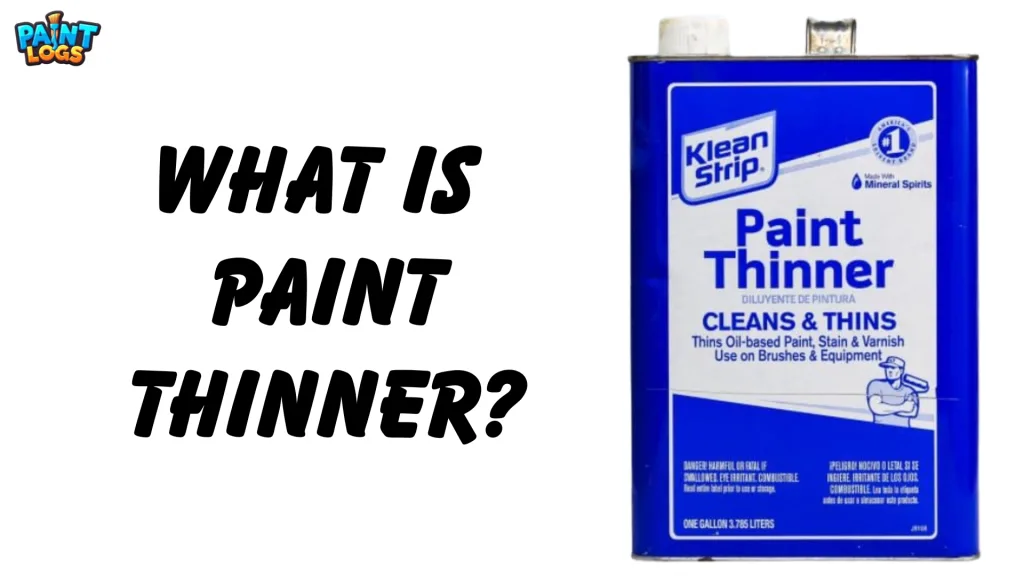
Mineral Spirits vs Paint Thinner: Key Differences
Here’s a side-by-side comparison to make things clear:
| Feature | Mineral Spirits | Paint Thinner |
|---|---|---|
| Composition | Refined petroleum distillate (Stoddard solvent) | Blend of solvents; may include mineral spirits |
| Odor | Mild; odorless versions available | Strong chemical smell |
| Toxicity/VOCs | Lower VOCs (still ventilate) | Higher VOCs; more irritating |
| Evaporation | Slower; more control | Faster; more aggressive |
| Price | Slightly higher | Usually cheaper |
| Best For | Thinning oil paint, cleaning brushes, wood prep | Heavy-duty cleaning; tar/adhesives |
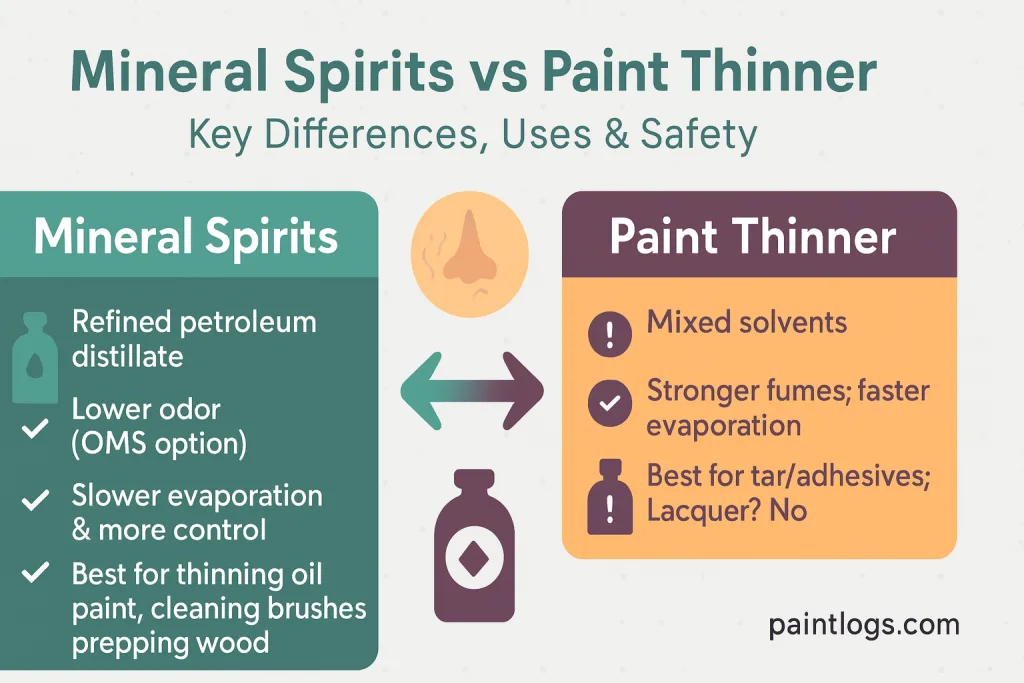
Mineral Spirits vs Paint Thinner for Cleaning Brushes
One of the most common reasons people buy these solvents is to clean oil-based paint from brushes and rollers.
- Mineral spirits are the gentler option. They dissolve oil paint effectively without stripping the natural oils out of high-quality bristles. If you’re working with artist brushes or expensive natural-hair tools, mineral spirits are safer.
- Paint thinner can certainly do the job, but because it often contains harsher solvents, it may dry out or weaken bristles over time. It’s better reserved for inexpensive shop brushes you don’t mind wearing out.
👉 Tip: Always start by wiping away as much paint as possible with a rag or paper towel. Then swish your brush in a jar of mineral spirits. Repeat with fresh solvent until the bristles are clean. For artist brushes, follow up with mild soap and water.
Mineral Spirits vs Paint Thinner for Wood Projects
Woodworking is another area where choosing the right solvent matters.
- Mineral spirits are ideal for wiping down raw wood before staining. They lift away dust, resin, or oily residues without raising the grain of the wood. This ensures an even, blotch-free stain application.
- Paint thinner can also clean wood, but because it’s harsher and evaporates faster, it may leave streaks or even soften some finishes. It’s not the best choice if your goal is precision or fine finishing.
👉 Best practice for woodworkers: Use mineral spirits to preview how a stain will look. Wiping a small area with mineral spirits temporarily darkens the wood, simulating the finished appearance.
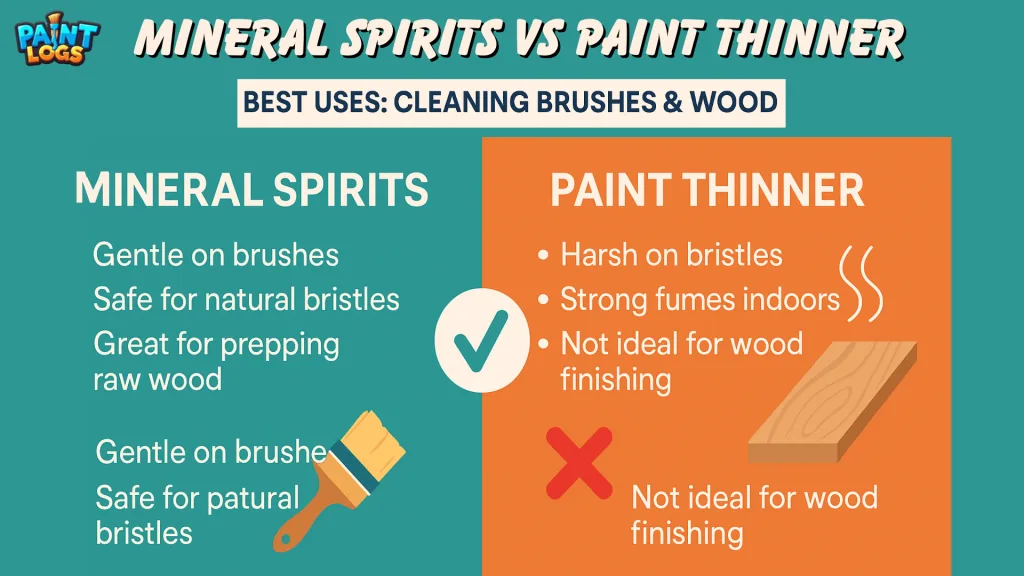
Odorless Mineral Spirits vs Paint Thinner
If you’re working indoors, ventilation is everything. Both solvents are flammable and release VOCs (volatile organic compounds), but odorless mineral spirits have a clear advantage.
- Odorless mineral spirits are highly refined to remove most of the aromatic compounds responsible for that strong chemical smell. This makes them far more comfortable for artists, DIYers, and hobbyists working in enclosed spaces.
- Paint thinner, by contrast, almost always comes with a harsh, lingering odor that can cause headaches or nausea in poorly ventilated rooms.
👉 Safety reminder: Even odorless mineral spirits still emit VOCs—you may not smell them, but they’re there. Always crack a window, use a fan, and wear gloves when working with solvents.
Mineral Spirits vs Paint Thinner vs Acetone
Acetone is one of the strongest, fastest-evaporating solvents you can buy. It’s commonly found in nail polish remover and industrial cleaners.
- Strength: Acetone dissolves cured paints, adhesives, and resins—jobs that mineral spirits or paint thinner can’t touch.
- Control: Mineral spirits evaporate slowly, giving you more working time, while acetone flashes off quickly.
- Safety: Acetone’s fumes are harsher and it’s extremely flammable. It also dries skin on contact.
👉 Verdict: Use mineral spirits or paint thinner for everyday cleaning and thinning. Reach for acetone only when dealing with stubborn, cured coatings or adhesives.
Mineral Spirits vs Paint Thinner vs Turpentine
Turpentine is a natural solvent distilled from pine resin. Traditionally used by painters and woodworkers, it’s now less common due to its strong odor and higher toxicity.
- Artists: Turpentine has long been used to thin oil paints, but many modern artists prefer odorless mineral spirits for health reasons.
- Woodworking: Mineral spirits are less aggressive and leave fewer residues compared to turpentine.
- Cost: Turpentine is often more expensive than both mineral spirits and paint thinner.
👉 Verdict: Mineral spirits are the modern, safer replacement for turpentine, especially in studios and workshops.
Mineral Spirits vs Paint Thinner vs Lacquer Thinner
Lacquer thinner is a powerful blend (usually including acetone, toluene, and methanol) designed specifically for thinning lacquer and cleaning lacquer-based products.
- Strength: Much stronger than either mineral spirits or paint thinner—lacquer thinner can dissolve plastics, cured finishes, and resin.
- Versatility: Mineral spirits can’t thin lacquer, and paint thinner isn’t strong enough.
- Risk: Lacquer thinner evaporates extremely fast and produces intense fumes.
👉 Verdict: Only use lacquer thinner if you’re working with lacquer products. For paints and general cleanup, mineral spirits are safer and easier to handle.
| Solvent | Primary Uses | Strengths | Cautions |
|---|---|---|---|
| Mineral Spirits | Thin oil-based paints, clean brushes, prep wood | Refined, controllable, lower odor (OMS) | Flammable; ventilate; possible light residue |
| Paint Thinner | General cleaning; cutting heavy grime/tar | Cheaper, stronger blends | Higher fumes/VOCs; harsher on bristles |
| Acetone | Remove cured paint/adhesives; degrease | Very strong; fast evaporating | Very flammable; dries skin; harsh fumes |
| Turpentine | Traditional oil-paint thinner | Works well with artists’ oils | Strong odor; higher toxicity; pricier |
| Denatured Alcohol | Thin shellac; clean glass/marker | Residue-free; fast evaporating | Toxic (not drinkable); flammable |
| Lacquer Thinner | Thin/clean lacquer products | Dissolves resins & some plastics | Intense fumes; only for lacquer systems |
Safety Tips for All Solvents
No matter which solvent you choose—mineral spirits, paint thinner, acetone, or denatured alcohol—safety should always come first. These products are flammable, volatile, and potentially harmful if inhaled or touched directly.
1. Ventilation Is Key
Always work in a well-ventilated area. Open windows, run a fan, or work outdoors when possible. Even odorless mineral spirits release VOCs you can’t smell.
2. Wear Protective Gear
- Nitrile or chemical-resistant gloves (avoid latex, which acetone can dissolve).
- Safety glasses or goggles when pouring or wiping.
- A respirator mask if working indoors with large amounts.
3. Fire Safety
- Keep solvents away from open flames, sparks, or pilot lights.
- Don’t smoke while using them.
- Store in tightly sealed containers, away from heat.
4. Skin and Eye Contact
- Solvents can dry or irritate skin—wash immediately with soap and water if contact occurs.
- If splashed in eyes, flush with water for 15 minutes and seek medical help.
5. Disposal
Never pour solvents down the drain. Used mineral spirits, paint thinner, or acetone should be collected in a sealed metal container and taken to a hazardous waste facility. Some areas allow you to let small amounts evaporate outdoors, but always check local regulations.
👉 Remember: “Odorless” doesn’t mean “non-toxic.” Always treat solvents with caution.
Final Verdict: Which Should You Use?
Choosing the right solvent depends on the job. Here’s a quick breakdown:
| Task | Best Choice | Why |
|---|---|---|
| Thin oil-based paint/varnish | Mineral Spirits | Refined; smooth flow; lower odor |
| Clean oil paint brushes | Mineral Spirits | Gentle on bristles; effective cleanup |
| Prep raw wood before staining | Mineral Spirits | Lifts oils/dust without raising grain |
| Heavy tar/adhesive removal | Paint Thinner | Stronger solvency for stubborn messes |
| Thin shellac / pristine glass | Denatured Alcohol | Fast-evaporating; residue-free |
| Remove cured paint/epoxy | Acetone | Very strong; dissolves hardened coatings |
| Indoor cleanup (low smell) | Odorless Mineral Spirits | Reduced odor; still ventilate |
| Work with lacquer systems | Lacquer Thinner | Formulated for lacquer only |
👉 Bottom line:
- Use mineral spirits for most everyday painting and woodworking tasks.
- Use paint thinner only when you need extra strength and don’t mind the fumes.
- Keep acetone and denatured alcohol on hand for specialized jobs.
With the right solvent on your shelf, you’ll clean smarter, paint better, and avoid costly mistakes. Next time you’re at the hardware store, you’ll know exactly which can to grab.
FAQs About Mineral Spirits vs Paint Thinner
Is mineral spirits the same as paint thinner?
Not exactly. Mineral spirits are a refined petroleum product, while paint thinner is a broader term that may include mineral spirits plus other solvents. All mineral spirits can be used as paint thinner, but not all paint thinners are pure mineral spirits.
Which is safer—mineral spirits or paint thinner?
Mineral spirits are generally safer, especially in odorless form. They contain fewer toxic additives and produce less harsh fumes compared to standard paint thinner.
Can I use mineral spirits instead of paint thinner?
Yes. Mineral spirits can replace paint thinner for thinning oil-based paints, cleaning brushes, and prepping wood. In most cases, they perform better and more safely.
Can I use paint thinner to clean oil paint brushes?
Yes, but it’s harsher on bristles and produces stronger fumes. Mineral spirits are recommended for long-term brush care, especially with high-quality or natural-hair brushes.
Are mineral spirits safe to use indoors?
Odorless mineral spirits are safer for indoor use, but all solvents release VOCs. Always ensure proper ventilation and use gloves.
What is the difference between mineral spirits, paint thinner, and turpentine?
Mineral spirits: Refined petroleum solvent, mild odor, widely used for painting and woodworking.
Paint thinner: General category; may contain mineral spirits or harsher additives.
Turpentine: Distilled from pine resin, strong odor, traditional for artists but less popular today.
Can I use acetone instead of mineral spirits?
Not usually. Acetone is much stronger and evaporates too quickly for thinning paints or prepping wood. It’s best for removing cured paint, adhesives, or nail polish.
Is denatured alcohol the same as mineral spirits?
No. Denatured alcohol is ethanol mixed with additives and is mainly used for thinning shellac or cleaning glass. Mineral spirits are petroleum-based and work for oil-based paints and wood prep.
Do mineral spirits leave a residue?
Regular mineral spirits may leave a slight oily residue. Odorless and highly refined versions leave little to none, which is why they’re favored by artists and woodworkers.


